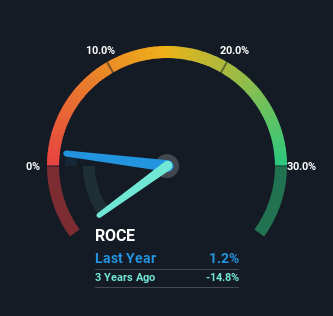Vulcan Minerals (CVE:VUL) Is Doing The Right Things To Multiply Its Share Price
Did you know there are some financial metrics that can provide clues of a potential multi-bagger? Amongst other things, we'll want to see two things; firstly, a growing return on capital employed (ROCE) and secondly, an expansion in the company's amount of capital employed. Basically this means that a company has profitable initiatives that it can continue to reinvest in, which is a trait of a compounding machine. With that in mind, we've noticed some promising trends at Vulcan Minerals (CVE:VUL) so let's look a bit deeper.
Understanding Return On Capital Employed (ROCE)
If you haven't worked with ROCE before, it measures the 'return' (pre-tax profit) a company generates from capital employed in its business. Analysts use this formula to calculate it for Vulcan Minerals:
Return on Capital Employed = Earnings Before Interest and Tax (EBIT) ÷ (Total Assets - Current Liabilities)
0.012 = CA$559k ÷ (CA$47m - CA$197k) (Based on the trailing twelve months to December 2023).
Thus, Vulcan Minerals has an ROCE of 1.2%. Ultimately, that's a low return and it under-performs the Metals and Mining industry average of 1.7%.
See our latest analysis for Vulcan Minerals
Historical performance is a great place to start when researching a stock so above you can see the gauge for Vulcan Minerals' ROCE against it's prior returns. If you'd like to look at how Vulcan Minerals has performed in the past in other metrics, you can view this free graph of Vulcan Minerals' past earnings, revenue and cash flow.
So How Is Vulcan Minerals' ROCE Trending?
The fact that Vulcan Minerals is now generating some pre-tax profits from its prior investments is very encouraging. The company was generating losses five years ago, but now it's earning 1.2% which is a sight for sore eyes. In addition to that, Vulcan Minerals is employing 2,246% more capital than previously which is expected of a company that's trying to break into profitability. This can indicate that there's plenty of opportunities to invest capital internally and at ever higher rates, both common traits of a multi-bagger.
The Key Takeaway
Overall, Vulcan Minerals gets a big tick from us thanks in most part to the fact that it is now profitable and is reinvesting in its business. And with the stock having performed exceptionally well over the last five years, these patterns are being accounted for by investors. With that being said, we still think the promising fundamentals mean the company deserves some further due diligence.
Since virtually every company faces some risks, it's worth knowing what they are, and we've spotted 3 warning signs for Vulcan Minerals (of which 1 is potentially serious!) that you should know about.
While Vulcan Minerals may not currently earn the highest returns, we've compiled a list of companies that currently earn more than 25% return on equity. Check out this free list here.
Have feedback on this article? Concerned about the content? Get in touch with us directly. Alternatively, email editorial-team (at) simplywallst.com.
This article by Simply Wall St is general in nature. We provide commentary based on historical data and analyst forecasts only using an unbiased methodology and our articles are not intended to be financial advice. It does not constitute a recommendation to buy or sell any stock, and does not take account of your objectives, or your financial situation. We aim to bring you long-term focused analysis driven by fundamental data. Note that our analysis may not factor in the latest price-sensitive company announcements or qualitative material. Simply Wall St has no position in any stocks mentioned.

 Yahoo Finance
Yahoo Finance 
